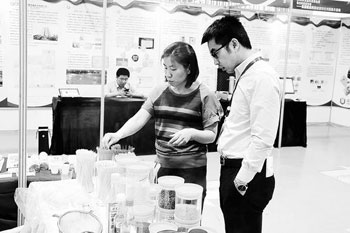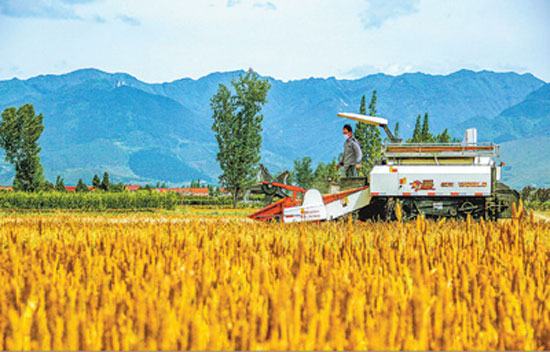Grains added to noodles technology transformation bridge
Original title: transformation of achievements: making "new tricks" from the "old three" of grain

The staff introduced miscellaneous grain noodles to the exhibitors. Photo by Shi Yonghao
"I didn't expect to be so busy today. The materials we brought were taken out in half an hour and our business cards were gone." Zhou Qiangbing, from the Institute of Mechanical and Electrical Technology of the Chinese Academy of Agricultural Mechanization, told China Science Daily that it was the first time he had seen such a hot scene.
From May 17 to 18, the 2016 Grain Science and Technology activity week and the first Grain Science and Technology Achievement Transformation and Promotion activity was held at Wuhan University of Light Industry, attracting more than 1500 participants from nearly 700 units.
Behind the lively scene is the urgent need for docking and cooperation among science and technology, talents and industries in the grain industry. Science and technology is not only the greatest potential for Chinese people to hold on to their own rice bowls, but also the fundamental way out. The transformation of science and technology is the "bull's nose" of scientific and technological work. Under the background of the implementation of the strategy of "invigorating grain through science and technology", promoting the transformation of scientific and technological achievements is of great significance to the transformation and upgrading of the grain industry, increasing the added value of grain and oil processed products, and promoting supply-side structural reform.
"the purpose of this activity is to do a good job in popularizing scientific and technological knowledge and achievements in accordance with the requirements of supply-side structural reform, and to realize the 'three docking' between grain scientific and technological achievements, talent teams, scientific research institutions and grain enterprises. really let the grain industry economy insert the wings of science and technology, and make the traditional grain industry fly high." Xu Ming, deputy director of the State Grain Administration, said at the opening ceremony of the event.
Market leader, innovative products, value-added grain processing.
Noodles are the most common traditional staple food on the Chinese table. At the scene of the first grain scientific and technological achievements transformation and docking promotion activity, the reporter found that miscellaneous grain and bean noodles developed by the Scientific Research Institute of the State Grain Administration and produced by Hunan Grain Group Yuxiang Food Co., Ltd. are very popular.
Why do you want "miscellaneous grains and beans + hanging noodles"? Tan Bin, a researcher at the Scientific Research Institute of the State Grain Administration, told China Science Daily that in recent years, Chinese residents have a high incidence of chronic diseases, and ordinary people pay more attention to and pursue a nutritious and healthy diet, which provides a great space for the development of miscellaneous grain products. However, miscellaneous grains and beans are basically consumed in the form of raw grains, and "I don't know what to do" is the embarrassment faced by miscellaneous grains when they come to the table of the common people.
"our idea is to take a large number of traditional staple foods as the carrier to develop miscellaneous grains as staple foods." Seeing such market demand, Tan Bin and his team put forward the research idea and carried out the research.
However, it is not easy to add miscellaneous grains to ordinary noodles.
Generally speaking, when the addition of miscellaneous grains and beans is more than 5%, the taste of the noodles will be affected; if the addition is more than 10%, the noodles will be difficult to Calendering. Tan Bin led the team to develop the "Nutrition and Health Noodle processing Technology with High Cereal and Bean content". Through the application of physical modification, appropriate particle size control and preparation of premixed powder, the bottleneck problem that it is difficult to use high content miscellaneous grains and beans in traditional staple food noodles has been solved. It is understood that hanging noodles with more than 60% addition of miscellaneous grains and beans can be obtained by using this technology without adding other additives.
At present, a series of high miscellaneous grain bean noodles produced by this technology have been listed in Beijing, Shanghai, Guangzhou and other places, and the market response is enthusiastic. The reporter searched on an e-commerce platform and found that the price of this product is three times higher than that of ordinary noodles of the same weight.
"China's grain and oil processing enterprises are currently in a small profit stage, the grain processing industry is facing transformation and upgrading, to achieve industrial upgrading, there must be new support points and economic growth points." Tan Bin said: although the relevant technological transformation and industrialization of achievements have just started, there should be a lot of room for development in the future.
Technology upgrading, efficient transformation, extension of industrial chain
Broken rice is the most important by-product resource produced during rice processing, accounting for about 10% to 15% of the total rice. Except for defective appearance, high impurity rate and affecting edible taste, the main composition, protein and starch content of broken rice have not changed.
It is understood that the total amount of broken rice in China reaches 11 million ~ 12 million tons every year, but most of them are treated as feed and the added value is very low. How to make full use of broken rice resources? The research team of the National Engineering Laboratory of Grain fermentation Technology and Technology of Jiangnan University studied the deep processing of broken rice.
The researchers used a new biochemical separation method to separate the effective components from broken rice, and then used them as rice starch, rice starch sugar and rice protein respectively according to their properties and characteristics.
Compared with the direct sale as feed, the deep processing of broken rice extends the rice processing industry chain, improves the utilization rate of food resources, and greatly increases the added value of the rice industry.
Among them, rice protein is a kind of high-nutrition, hypoallergenic high-quality plant protein, which is often used as a nutritional supplement and widely used in the food industry.
"We have used the protein dregs produced in the production of starch sugar and used patented technology to produce food-grade rice protein with a purity of more than 80%." Chen Zhengxing, a professor at the School of Food at Jiangnan University, said in an interview.
Through deep processing, food-grade rice protein is extracted from feed-grade rice residue, and its economic value is much higher. "the price as feed is several thousand yuan per ton, but the export price of rice protein can reach 25000 yuan per ton, a five-fold increase." Chen Zhengxing revealed that at present, the research team has docked and transformed technological achievements with enterprises such as Wuxi Jinnong Biotechnology Co., Ltd., and different types of rice protein powder have been introduced, and enterprises have achieved good economic benefits.
Transformation of grain scientific and technological achievements to promote supply-side reform
Deep processing of broken rice is a successful case of deep processing and high efficiency transformation, but on the whole, the utilization rate of rice resources in China's rice processing industry is only 1RV 1.3, which is far lower than the international advanced level, which is far lower than the international advanced level. Generally speaking, the technical content is not high and the added value is low.
The field of deep processing of corn is also facing the same crux. Yue Guojun, academician of the Chinese Academy of Engineering, mentioned in the popular science lecture in the Grain Hall of the event on May 18 that there are less than 1000 corn processing products in China, while there are about 3500 corn processing products in the United States. "in China, high value-added products are still in the early stages of growth and there is a lot of room for growth." Yue Guojun said.
To change the current situation of China's grain industry, we must rely on "invigorating grain through science and technology", and the transfer and transformation of scientific and technological achievements is the key. "if the grain industry really wants to shoulder the important mission of ensuring national food security, it must implement the strategy of 'invigorating grain through science and technology'. If grain enterprises want to become stronger and bigger, they must put science and technology in a prominent position, make up the 'deficiency', and catch up." Xu Ming, deputy director of the State Grain Administration, said at the opening ceremony of the event.
The "hand in hand" between Henan Huangguo Grain Co., Ltd. (hereinafter referred to as Huangguo Grain Industry) and the research team of the School of Food Science and Engineering of Wuhan University of Light Industry is one of the typical production cases in which scientific research institutions transform scientific and technological achievements efficiently and enterprises make use of science and technology to become stronger and bigger. In view of the lack of targeted and increasingly specialized market feedback on general glutinous rice flour, Huangguo Grain Industry and Wuhan University of Light Industry jointly carried out the research on the value-added technology of comprehensive utilization of glutinous rice flour. Around the glutinous rice flour processing research and development, declared a number of technological invention patents and results sharing.
Related
- A course of planting techniques and methods on how to grow carrots
- How to plant the latest tulips?
- Is it better to pick tea in the morning or in the afternoon? When is the best time for tea to be picked? what is the third or fifth tea?
- Launch Yuanxiao Happy combination Haocha + Tea Yuan healthy Taste
- Penghu Tourism "Fireworks 20 Parade with You"
- 2022 West Lake Happiness holds "Digital Revitalization Voucher" and draws iphone13 and laptop.
- Banqiao Fuzhou social houses are designed to change start-up combined with police elimination to create a safe and livable environment
- The convenient measure of "mechanical weeding" in Xinbei has been abused and the Agriculture Bureau has imposed heavy penalties on the illegal land consolidation.
- Changgeng University Joins Hands with Four Memory Factories to Rescue Memory Talent Shortage
- The list of Taiwan's top 100 MVP managers is listed by the Director-General of the Farmers' Association of Sanxia District.



